HOME PAGE | < Previous | Contents | Next >
Internal Finisher SR3130 (D690)
Staple eject mechanism
Staple eject requires that transported paper is temporarily stored in a staple tray. After rear edge detection of the transported paper is performed by a transport sensor, a positioning roller unit descends and transports it to a staple tray.
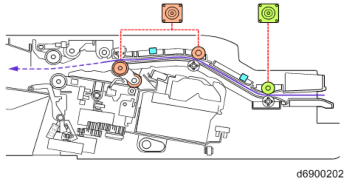
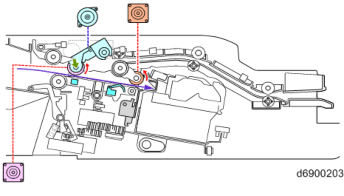
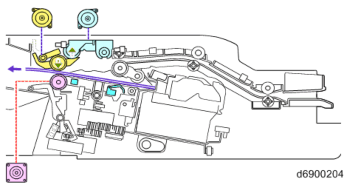
Positioning roller ascent/descent mechanism
The positioning roller unit is made to ascend/descend by a positioning roller up/down drive motor (the motor operates CW/CCW), and its position is detected by a Home Position sensor. The positioning roller rotates in the opposite direction to the transport roller, and has the function of transporting paper to the back of the staple tray.
Internal Finisher SR3130 (D690)
INTERNAL FINISHER SR3130 (D690)
INTERNAL FINISHER SR3130 (D690)
INTERNAL FINISHER SR3130 (D690)
Paper rear edge alignment mechanism
The rear edge of paper transported by the positioning roller is made to project against a rear trailing edge fence by a reverse roller. It rotates continuously until the bundle of paper is ejected after it is stapled.
The reverse roller is driven from a transport roller via a gear, and is always situated above the stapler tray. A driven roller is installed on the side of the stapler tray which reduces wear of the reverse roller.
Paper detection on stapler tray
The stapler tray is provided with the following sensors which detect paper status in the tray.
Paper jam in tray: tray jam sensor
Paper present/absent in tray: paper sensor
Jogger mechanism (paper alignment)
Paper transported to the stapler tray is aligned one sheet at a time by a jogger fence. The jogger fences are driven forwards and backwards independently, and align the paper with the tray center. Jogger fence drives are installed at the front and back. Home Position sensors are also installed at the front and back.
When the paper alignment is performed, the jogger fences move from the home position, and stand by 7 mm away from the paper to be stapled. When the paper is then transported to the tray, the jogger fence (rear) moves according to the paper size and aligns the paper. The jogger fence (rear) stands by 7 mm away from the paper, and again moves 7 mm towards the paper in order to perform paper alignment, so it moves a total of 14 mm. During the paper alignment, the jogger fence (rear) repeats this movement.
Internal Finisher SR3130 (D690)
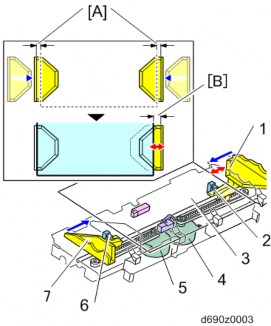
[A]: 7mm
[B]: 14mm
No. | Description | No. | Description |
1 | Jogger fence (rear) | 5 | Jogger fence displacement motor (front) |
2 | Jogger fence Home Position sensor (rear) | 6 | Jogger fence Home Position sensor (front) |
3 | Stapler tray | 7 | Jogger fence (front) |
4 | Jogger fence displacement motor (rear) |
Internal Finisher SR3130 (D690)
Stapler movement mechanism
INTERNAL FINISHER SR3130 (D690)
INTERNAL FINISHER SR3130 (D690)
INTERNAL FINISHER SR3130 (D690)
Stapler specification is as follows:
There are three stapling positions, i.e., one front parallel, one back parallel and two parallel.
30 large sheets or 50 small sheets can be stapled.
To change the stapling position, a mechanism is provided which moves the stapler. The stapler is moved by a stapler motor, and the home position is detected by a Home Position sensor.
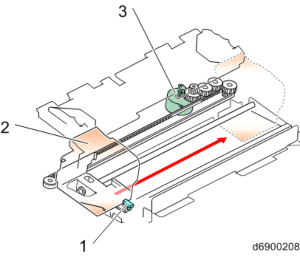
No. | Description | No. | Description |
1 | Stapler Home Position sensor | 3 | Stapler retreat motor |
2 | Stapler |
The stapler moves from the home position to the paper size to be stapled, and temporarily stands by. Next, the paper is transported, and after the jogger operation (paper alignment), stapling is performed.
The following picture shows the stapler standby position according to various stapling positions. From the left, there is front parallel one position, back parallel one position, and parallel two positions.
For parallel two positions, the first staple is inserted from the front, and it then moves to the back to perform stapling.
Stapling is performed back and forth, i.e., the second staple is back > front, the third staple is front > back, etc.